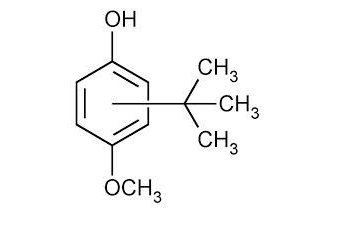Appearance waxy solid Melting point 48 °C Density 1.06 g/cm³ | Formula C11H16O2 Molar mass 180.24 g/mol Boiling point 264 °C | |
 | ||
Related compounds IUPAC ID 2-tert-Butyl-4-hydroxyanisole and 3-tert-butyl-4-hydroxyanisole (mixture) Soluble in Methanol, Propylene glycol, Ethanol | ||
Butylated hydroxyanisole
Butylated hydroxyanisole (BHA) is an antioxidant consisting of a mixture of two isomeric organic compounds, 2-tert-butyl-4-hydroxyanisole and 3-tert-butyl-4-hydroxyanisole. It is prepared from 4-methoxyphenol and isobutylene. It is a waxy solid used as a food additive with the E number E320. The primary use for BHA is as an antioxidant and preservative in food, food packaging, animal feed, cosmetics, rubber, and petroleum products. BHA also is commonly used in medicines, such as isotretinoin, lovastatin, and simvastatin, among others.
Contents

Antioxidant properties

Since 1947, BHA has been added to edible fats and fat-containing foods for its antioxidant properties as it prevents rancidification of food which creates objectionable odors. Like butylated hydroxytoluene (BHT), the conjugated aromatic ring of BHA is able to stabilize free radicals, sequestering them. By acting as free radical scavengers, further free radical reactions are prevented.
Research

The U.S. National Institutes of Health report that BHA is reasonably anticipated to be a human carcinogen based on evidence of carcinogenicity in experimental animals. In particular, when administered in high doses as part of their diet, BHA causes papillomas and squamous cell carcinomas of the forestomach in rats and Syrian golden hamsters. In mice, there is no carcinogenic effect, and even evidence of a protective effect against the carcinogenicity of other chemicals.
When examining human population statistics, the usual low intake levels of BHA show no significant association with an increased risk of cancer. The State of California, has, however, listed it as a carcinogen.
